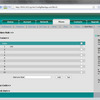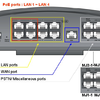Check out my Phybridge PoLRE Review, a suite of three products that let you use your existing phone wiring to deploy VoIP with full Power over Ethernet capabilities. The three products are the PoLRE LPC 8 Port Switch targeting the SMB and the PoLRE PL-024 & PoLRE PL-048 switches, which target larger deployments. Since the PL-024 and PL-048 are nearly identical except for port sizes (24 vs. 48) I checked out the larger model. The cost savings using these products are immense, especially in large multi-building sites such as a campuses, government facilities, etc. The Phybridge product line had other advantages over traditional Ethernet, including much longer distances. Check out the review, which is the cover story in the November issue of Internet Telephony Magazine.
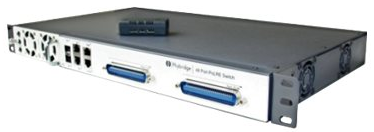

PoLRE PL-048 PoLRE LPC 8
Optimizing the local area network for voice and data convergence is a critical starting point for any customer looking to migrate to IP telephony and unified communications. Until the Phybridge switch innovation was introduced, common practice was to rip and replace the existing data LAN to support the IP phone and UC applications. For some customers these requirements are too great an operational and financial barrier to overcome. That’s exactly what Phybridge’s line of Power over Long Reach Ethernet (PoLRE) switches does, delivering Ethernet and Power over Ethernet over a single pair of wires with distances up to an impressive 1,200 feet. That’s four times the maximum distance offered by traditional Ethernet, which is limited to just 300 feet. Using your existing voice wiring infrastructure you can deploy the latest VoIP phone systems and IP phone endpoints completely separate from your existing LAN infrastructure, moving the convergence point from every desktop with the IP phone acting as a switch for the data device to a single point in the central closet.
Phybridge President Oliver Emmanuel explained to TMC Labs, “This is not intended to displace the data switch fabric. It’s there to complement and optimize it for voice and data convergence.” He added that the company’s ideal customers are those that have a single data drop and a single voice drop at each workstation and want to move to IP telephony. He explained that the product is not for smaller businesses with two data drops. In those scenarios, he admitted, it is cheaper to just have separate PoE switches than going with Phybridge’s solutions. If the customer has one data drop and a voice drop and wants a robust backbone supporting its IP phones, then the Phybridge PoLRE switches are a great fit. The larger the customer, the more complex the LAN and the greater the requirements. Often what gets forgotten are IDF closet requirements given the introduction of PoE switches. Considerations include power availability, backup power requirements and cooling for all the IDF closets. With the Phybridge switches being consolidated in the MDF, these requirements go away. In addition, you can use Phybridge’s network, which leverages ubiquitous phone wiring, as a backup network should the primary LAN infrastructure fail, due to hardware failure, or even a denial of service attack. More on that later.
It’s important to note that CAT5 Ethernet switches max out at 300 feet, while Phybridge is rated to go as far as 1,200 feet over a single pair delivering both Ethernet and PoE. Phybridge told TMC Labs that it tested all 48 ports at 1,200 feet delivering Ethernet and PoE with no issues. Phybridge also said it has some customers running at 1,800 feet, but it’s unsupported. Phybridge mentioned it has lots of universities using it products, especially since it has several buildings and can consolidate the switching fabric.
PoLRE vs. Uniphyer
Before PoLRE, Phybridge sold a product line called Uniphyer, which uses ADSL2+ technology. With the newer PoLRE, Phybridge was the first to combine Power with Long Reach Ethernet. The Uniphyer line can reach up to 5km (2 miles) distance, but the drawback is that it requires local power to the adapter and phone beyond 1,200 feet. It has asymmetric bandwidth with up to 24mbps download speeds and 1mbps upload speeds. The PoLRE line has a smaller distance range, but provides power (10W/port) and has symmetrical 10mbps speed. Both have their place in the market and the company will continue to sell both, but Phybridge told TMC Labs it believes the Polar Line will become the dominant choice of customers due to the power and symmetric bandwidth advantages.
TMC Labs took two of Phybridge’s products for a test drive, including the PoLRE LPC 8 Port switch designed for SMBs, and the larger scale PoLRE PL-048 which has two RJ21 Amphenol ports (24 ports each) allowing for up to 48 devices to be connected. It also has a third model, the PL-024, which as its name suggests, has a single RJ21 Amphenol port for 24 ports of network connectivity. Both products can guarantee the quality of service for all of the VoIP endpoints, primarily because they are based on a point-to-point topology. Packets travel in order, on time, and without contention. Phybridge told TMC Labs the company had one customer using a ShoreTel phone system and it experienced a denial of service attack, which took down the data network for about two days. Because the ShoreTel phone system was on Phybridge on a separate network from the primary LAN infrastructure, voice was unaffected. This in itself makes the product a no-brainer for certain mission-critical verticals like health care, financial services, law offices, and other sectors that cannot afford to have any phone outages.
In unpacking the smaller unmanaged PoLRE LPC Switch, we saw it came with two PhyLink adapters, which are small inline adapters that connect the phone wire on one end and an Ethernet cable on the other, providing up to 10W of PoE power to IEEE 802.3af-compliant devices. After connecting an Ethernet cable to Uplink Port 1 on the device to join it to our LAN, we connected a standard RJ11 phone cable to port 1 of the PoLRE LPC Switch, and the other end of the phone cable to the PhyLink adapter. Next, we connected the other end of the Ethernet cable to an IP phone and the IP phone’s LCD lit up and the phone booted. We made a test call from the IP phone and, as expected, it sounded flawless.
Next, we tried out the larger PoLRE PL-048, which features dual-redundant hot-swappable power supplies and management capabilities. You can use either AC or DC power, but one nice feature if using DC power is you can easily daisy-chain the power using the input and output DC ports. Up to 4 PoLRE Switch units can be daisy-chained for Powershare and load balancing. If a power supply fails on any unit in the ring, the others are able to share the load, and the affected unit continues to operate normally. You can then replace the failed hot-swappable power supply with no downtime.
We connected the PL-048 to our LAN and then hooked up an Amphenol cable to a punchdown block, which was terminated to some ports around the office. It supports a maximum of two uplinks, each 1gbps (full duplex), using either two mini-GBIC ports or two RJ45 ports. We used the RJ45 uplink ports to attach to our LAN. Next, we did the same thing as before and connected Phylink adapters to a phone wire and an Ethernet cable that terminated to a PoE IP phone. Once again the phones booted and were able to successfully make calls.
Management Interfaces include both in-band and out-of-band management via the dedicated Mgmt port. It also has a serial console port if you want to go old-school. The web GUI is another innovation designed to simplify the configuration, management and troubleshooting of a Phybridge backbone. It is an intuitive offering that is easy to learn yet robust in its capabilities. There is no other switch GUI interface with this level of simplicity. First we checked out the web interface via the Mgmt port. We could view important stats such as status of each Ethernet port, CPU load, memory utilization, temperature, voltage, and the current amount of power being consumed by Power over Ethernet devices. Unlike many other switch GUIs, all this critical information is being updated dynamically without needing to hit the refresh button.
In a single snapshot you can easily determine the status of all ports. Grey means inactive, blue means ready for IEEE compliant device and green means a device is connected to the port. Hover over the port and you get more intelligence on the port. The web interface also displays any RX/TX errors individually by port, so you can easily see any troublesome ports. The PL-048 also lets you easily configure multiple VLANs and assign ports to each VLAN. From the Web UI you can also upgrade the firmware. Further, you can remotely manage the power capabilities – turn off or recycle ports. This comes in handy if a phone is acting up and an administrator needs to reboot it without user intervention. You can also lock down a port so only a single device will get connectivity based on the MAC address; this is handy for those looking for a highly secure platform: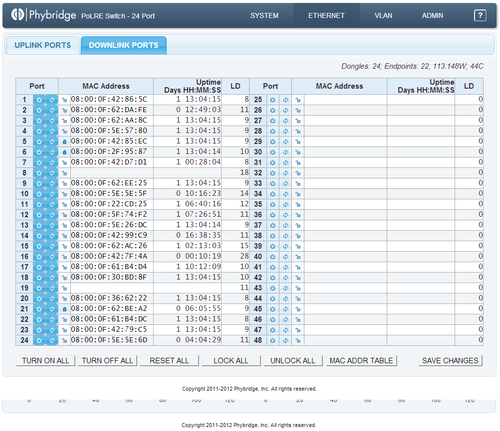
In addition, you can export and import the configuration for backup and migration purposes. Also in the web interface under the Admin section is the ability to stop or start services as well as set them to automatically start at bootup: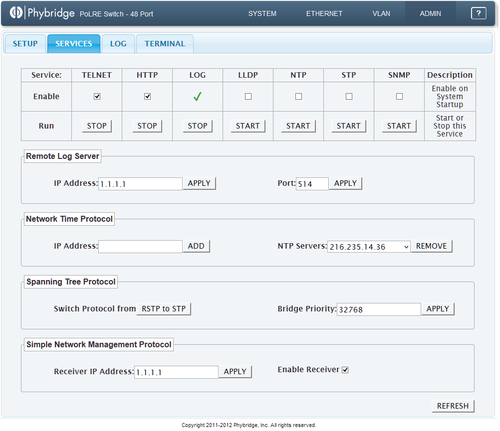
For instance, you can enable the telnet service, which gives you full telnet access to the Linux kernel. We were able to login and navigate the Linux operating system and issue Linux commands. We also enabled NTP and added one of our NTP servers to get the correct date and time configured on the device. We were able to configure logging, and even use the web-based CLI / terminal screen to issue commands. You can type commands manually or click on the web form field to see a drop-down list of commands, which you can then select. For troubleshooting, the unit has some nice features, including remote log server capabilities, SNMP, and web-based access to the log: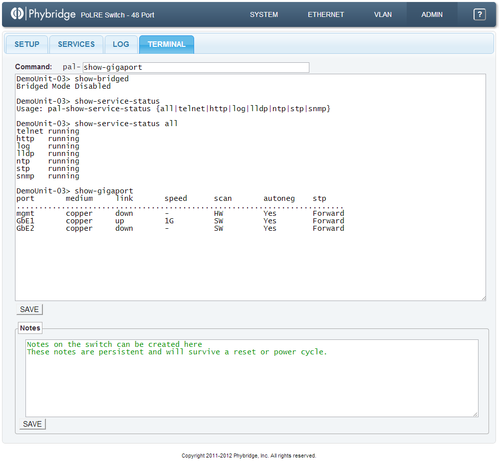
Bandwidth Test
Phybridge claims 10mbps switched Ethernet performance – so each port should have dedicated 10mbps bandwidth. We were curious how the bandwidth would perform, so for our next test we copied a large file across the network and were getting 1MB/s or 8mbps. For comparison, we copied this same file over our 1000mbps gigabit switches and achieved 60MB/s or 480mbps. Obviously, using Phybridge as your primary LAN is not the intended purpose of this device, but it’s nice to know you have a backup network solution if the primary network switches fail.
Cost Savings
TMC Labs knew the Phybridge solutions could cut down on the network switching and IDF closet infrastructure, and we were curious if Phybridge had any interesting case studies demonstrating cost savings. We learned about TransUnion Credit in Chicago, which has 1,400 users and an initial budget of $1.8 million. With Phybridge it came down to $300,000, saving them $1.5 million. The company fast tracked the deployment by six months and completed the 1,400 user migration in a single weekend. The obvious savings is in cabling, but even bigger savings come from eliminating the need for IDF closet(s) on each floor plus additional network switching equipment due to distance limitations of Ethernet.
Phybridge’s solution has four times the distance reach of Ethernet, thereby eliminating the need for IDF closets with additional networking equipment. TransUnion had 20 IDF closets, two on each floor (10 floors total) that required UPSs, PoE switches to power the IP phones, as well as power and cooling considerations. Add in professional services to install the equipment and the costs quickly add up. With Phybridge’s solution, it resides in the MDF where your legacy phone system equipment and cooling already lives, so it eliminates the complexity and costs of getting that network change completed. Further, with Phybridge, there are no worries about whether the LAN infrastructure is VoIP ready, and you don’t have to deal with the complexities of setting up VLAN and QoS settings.
While there’s nothing magical or earth-shattering about our test VoIP calls, it’s kind of interesting to think that we were making an IP phone call over just a single pair of wires. It’s been ingrained in our minds that we must rip and replace our entire LAN to gain the benefits of IP telephony and unified communications. So to think the existing phone wires can support data and indeed VoIP is a bit disconcerting. TMC Labs can envision the IT decision maker thinking, “Wait, you mean to tell me we can easily migrate to IP telephony leveraging our existing voice infrastructure without network or business disruption?” IT decision makers are accustomed to dealing with network complexity, so the simplicity of a Phybridge backbone supporting IP phones complimenting and extending the data LAN may seem foreign. Phybridge eliminates many of the LAN barriers associated with IP telephony adoption in a simple yet effective manner by leveraging an existing, proven and reliable voice infrastructure. Add in the fact that it also lets you consolidate your switching network equipment, backup power, and cooling, and Phybridge’s solutions are very cost-effective.
|
Roadmap & Conclusion
One cool product in the company’s roadmap (one or two years down the road) is a network Y-adapter, which the company has a patent on. It has a RJ11 to two RJ45 ports – one for the Phybridge network and the other for the traditional LAN infrastructure. The adapter would sense the health of the LAN, and if it goes down it will transfer the data on the fly to the Phybridge network and vice-versa. Now you have a true redundant voice and data network using a simple Y-adapter.
Also on the roadmap is 100MB/s and potentially 250MB/s bandwidth – all over a single pair, which would really make things even more interesting. Overall, TMC Labs is very impressed with the ease of use of the PoLRE PL-048’s web GUI, and the plug-and-play nature of both the PoLRE LPC 8 and the PoLRE PL-048. Companies looking to have PoE IP phones and other PoE devices have a viable and reliable solution in the Phybridge PoLRE product line, and TMC Labs wouldn’t hesitate to recommend it.
Pricing:
PoLRE PL-048 = ~$4400
PoLRE LPC 8 Port Switch = ~$640



